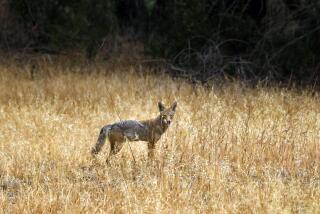The yip of the wild
I WANT MY damn coyotes back.
In the last few months, they’ve abandoned my neighborhood in the Hollywood Hills, apparently having been driven down by the cold, dry winter to Hancock Park and the Fairfax district. And you city slickers down there have been freaking out -- calling 911, waiting in your car until they leave. Even though these are creatures so harmless that their best line of defense is the Acme Corp.
Admittedly, when I moved out here from New York two years ago, I was uncomfortable with coyotes. For instance, I pronounced the last syllable. Also, I screamed and grabbed my wife, Cassandra, whenever I heard them nearby. This, by the way, did not turn her on.
Coyotes, I learned, don’t howl plaintively like wolves. They travel in packs and yip like drunken frat boys. After a few months, my wife and I got used to this and started to brag about the critters to our friends back East: Yeah, we have an outdoor grill, can take nature hikes from our front doorstep and fall asleep to the sound of yipping coyotes. In fact, Cassandra said she found the noises kind of romantic. She had a much more exciting college life than I did.
Then Cassandra woke up one morning, walked out the big sliding glass door onto our upper deck and saw a mangy coyote sleeping right in front of her. She screamed, it urinated and they both ran away. Kind of like how she and I ended our first date.
By and by, this is how we got our first pets. The coyote, and soon, his friend, decided to live permanently on our deck. They’d drink from the fountains, stay cautiously still when we walked by and otherwise ask for absolutely nothing. I’d nod at them and they’d look back. As a guy who has zero interest in animals I can’t eat, these were the first pets I actually liked. I was like Jack London, only some people read my stuff after eighth grade.
Our new pets ate our rodents, cleaned up dead animals, scared away skunks and kept cats and dogs in their houses where they belong. They didn’t eat our plants. Plus, our neighbors had to keep their smelly garbage cans shut tight. Sure, they ate the koi we put in our fountain three days after we got them, but really, who were we to get koi? I’m in California for 12 months and suddenly I’m Mr. Miyagi?
But all of a sudden, my beloved pets are gone. Which is wrong. We need coyotes in the hills to make us feel rich and countrified. Taking away our coyotes is like taking away our winding streets through which we can barely squeeze a Porsche Cayenne, or our hiking trails that double as casting couches.
To find out how to get them back, I called Stephanie Boyles, the wildlife biologist for People for the Ethical Treatment of Animals, because I figured she was likely to be as crazy as I am.
Boyles knew an awful lot about coyotes; she was in the middle of reading “God’s Dog: A Celebration of the North American Coyote” by Hope Ryden. She assured me that once it rains and warms up enough so that their prey comes out of semi-hibernation, the coyotes should abandon the easy food and water in the dangerous, car-filled lowlands and come back home.
And while Boyles strongly advised against leaving food out to lure them uphill (they’d stop learning how to hunt and mistakenly trust humans), she did have some suggestions to make my home more coyote friendly.
“You can plant things to attract rabbits and squirrels,” she suggested. Apparently, in PETA-world, it’s fine to kill animals as long as you have other animals do it for you. (I need to tell Ted Nugent about this loophole immediately. He could fashion a quiver of arrows out of woodpeckers, no problem.)
Though I’m not going to plant carrots and acorn trees, I am looking forward to the rains bringing my pet coyotes back. Part of this whole California thing, after all, is blending nature and urban living. And the other part is making the rest of the country think that you’re a freak.
*






